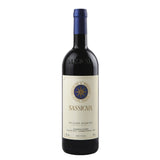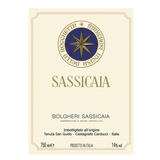- CRITICAL REVIEWS
- WINEMAKER NOTES
Robert Parker Wine Advocate
Vinous
2010 Tenuta San Guido Sassicaia Bolgheri, Tuscany, Italy
Appellation: D.O.C. Bolgheri Sassicaia
Grape blend: 85 % Cabernet Sauvignon 15 % Cabernet Franc
Soil composition: The vineyards are planted on plots of land with different and composite morphological characteristics, as well as with a strong presence of limestone. These areas are also rich in rocks and rather rich in clay and are located at an altitude between 100 and 300 meters above sea level, facing West - South/West.
Vine training: Cordon spur system
Planting density: Between 3.600 to 5.500 vine stocks/Ha for older vineyards and 6.200 vine stocks/Ha for newer vineyards.
Climate: Although not as rich in snow as the previous year, the climate in 2010 took us back in time: a long and cold winter, and a wet and cool spring. The bud burst was therefore regular, but certainly not precocious. During the winter we had temperatures below the seasonal average until the end of March and this allowed for the blocking of the vegetative phases of the vines. In mid-March we had significant snowfall and also the Spring was colder than usual, with temperatures below the seasonal average and heavy rains until May. This trend led to a delay in flowering and veraison and consequently, to a slower vegetative growth. Subsequently the temperatures aligned themselves to the seasonal average. This coupled with large temperature excursions between night and day, encouraged the development of perfumes. July was very hot and sunny with no rainfall and the development of the plants was regular, while in August we had about 70 mm of rains and the maximum temperatures did not exceed 32 degrees.
Harvest: The grape harvest started on the third week of September, 2 - 3 weeks later than the previous years, mainly due to the low temperatures during the Spring, which led to a delay in the development of the grapes. Harvesting ended in the second half of October, with perfectly ripe fruit, an excellent polyphenol development, sugar balance and alcohol content.
Wine making: The primary fermentation took place in temperature controlled stainless steel vats at a temperature of 30° - 31° C. The maceration of the skins lasted 15 days for both the Cabernet Sauvignon and the Cabernet Franc, with a combination of pumping over and délestage. The malolactic or secondary fermentation also took place in the steel vats.
Ageing: The wine is aged for 24 months in French oak barriques and a few more months in the bottle before being released on the market.










